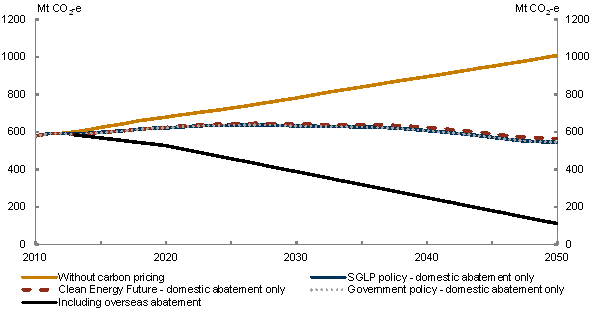Carbon pricing in Australia reduces emissions domestically and overseas. Without carbon pricing, Australia’s emissions would continue to rise steadily. Carbon pricing reduces Australia’s emissions by 159 Mt CO2‑e in 2020 compared to what would happen without carbon pricing, achieving Australia’s emission reduction target of 5 per cent below 2000 levels.1 Australia’s emissions in 2050 fall by 897 Mt CO2‑e, so emissions are 80 per cent less than 2000 levels. In all policy scenarios, domestic emissions are significantly lower throughout the period than the emission path without carbon pricing and decline after 2030.
Differences across scenarios in the starting prices and transport coverage affect how these environmental objectives are met, including the shares of abatement sourced domestically and overseas. The higher fixed carbon price path to 2014‑15 in the updated scenarios reduces cumulative domestic emissions by an additional 5 Mt CO2‑e over that period compared with the SGLP policy scenario. The permanent exclusion of heavy on‑road transport from carbon pricing in the Clean Energy Future scenario results in less domestic abatement than other policy scenarios, with more abatement sourced overseas.
Chart 1: Australian emissions in the policy scenarios

Note: Emissions without carbon pricing include Carbon Farming Initiative (CFI) abatement. CFI abatement is driven by the global carbon price, at which CFI permits are assumed to be sold, which is the same across all policy scenarios.
Source: Treasury estimates from MMRF.
Australian businesses covered by the scheme will be required to meet at least 50 per cent of their emission liabilities from domestic permits and credits until 2020. They can buy international permits to meet the balance, which will ensure their emissions are offset by abatement overseas. The modelling projects businesses will meet significantly more than 50 per cent of their emission liabilities from domestic permits and credits, and significantly less than 50 per cent through international permits in all policy scenarios, so the cap does not bind. For example, in the Clean Energy Future scenario, the modelling projects that Australian businesses source 97 Mt CO2‑e of abatement overseas in 2020, or 28 per cent of their annual liability under the scheme in that year. Of course, many factors influence the eventual share of emissions met by abatement sourced overseas. For example, the cap may be important if world prices are much lower than expected.
1 The reduction of 159 Mt CO2‑e in 2020 includes 7 Mt CO2‑e of abatement through the Carbon Farming Initiative. All results in this publication refer to the financial year ending 30 June of the year quoted unless otherwise indicated.